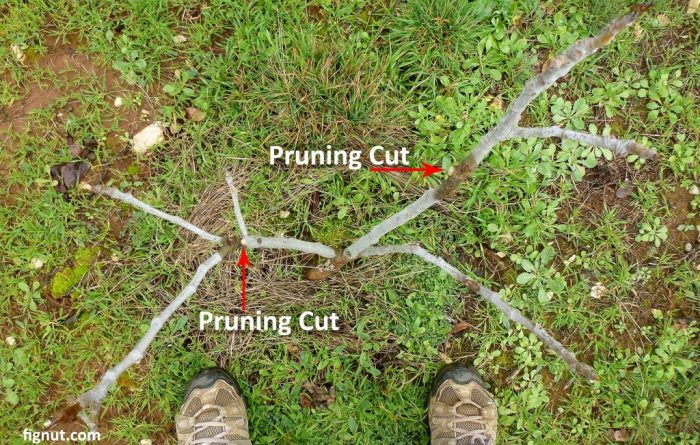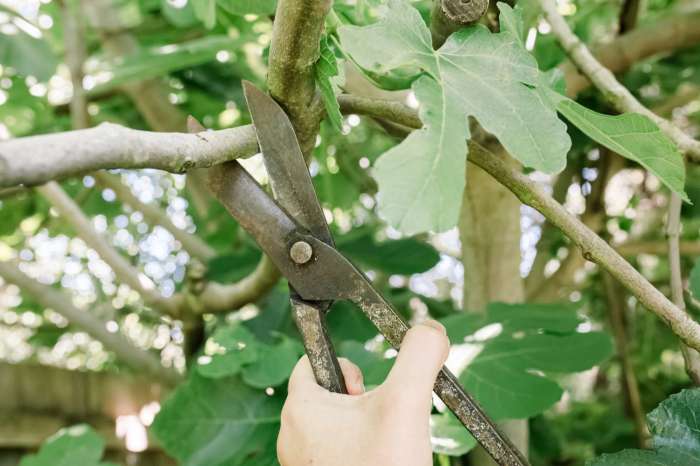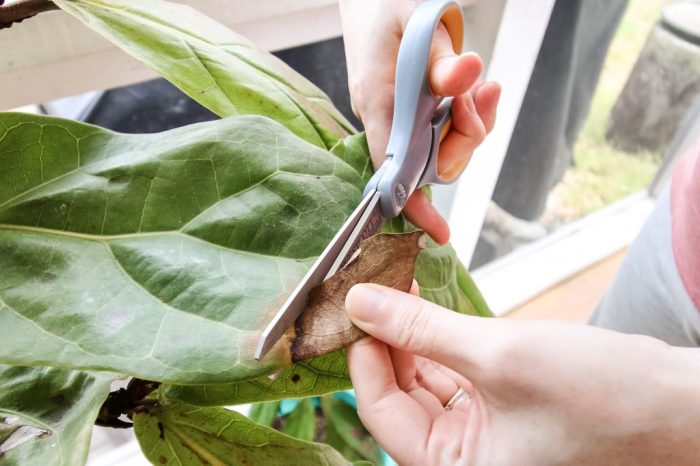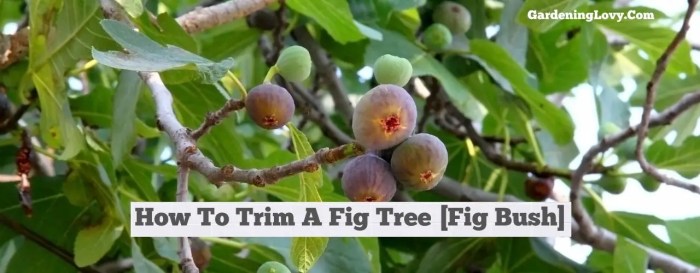How to trim fig plants is a crucial aspect of fig cultivation, as it significantly impacts the plant’s fruit production, overall health, and aesthetic appeal. Understanding the proper techniques and timing for trimming fig trees is essential for maximizing their yield and longevity.
In this comprehensive guide, we will delve into the intricacies of fig plant trimming, providing step-by-step instructions, tips, and insights to empower you with the knowledge and skills to care for your fig trees effectively.
Fig Trimming Basics

Fig trees benefit greatly from proper trimming, which enhances their health, productivity, and aesthetics. The ideal time to trim fig plants is during the dormant season, typically late winter or early spring. This allows for better visibility of the plant’s structure and minimizes the risk of disease transmission.When
selecting tools for fig trimming, opt for sharp, clean shears or pruners. Ensure they are appropriately sized for the branches being trimmed. Disinfection of the tools before and after use is crucial to prevent the spread of pathogens.
Techniques for Trimming
Trimming fig trees is crucial for maintaining their health, productivity, and desired shape. Various techniques are employed to achieve these objectives, including shaping and thinning the canopy, removing suckers and water sprouts, and pruning for specific purposes.
The specific trimming approach depends on the type of fig tree and its growth characteristics. Here are some general guidelines:
Trimming Young Fig Trees
- During the first few years, focus on establishing a strong framework of main branches.
- Remove any weak or crossing branches.
- Train the main branches to grow in desired directions using stakes or trellises.
Trimming Mature Fig Trees
- Thin out dense growth to improve air circulation and sunlight penetration.
- Remove any dead, diseased, or unproductive branches.
- Prune back long or unruly branches to maintain a manageable size and shape.
Shaping and Thinning the Canopy
- To create an open and airy canopy, remove branches that are growing inward or crossing each other.
- Thin out crowded areas by selectively removing branches to allow for better light distribution and fruit production.
- Use thinning cuts to remove entire branches back to their point of origin.
Removing Suckers and Water Sprouts
- Suckers are shoots that grow from the base of the tree and compete with the main branches for resources.
- Water sprouts are fast-growing, vertical shoots that typically appear on the trunk or main branches.
- Both suckers and water sprouts should be removed to prevent them from diverting energy from fruit production.
Maintenance and Care

Proper maintenance and care are essential for healthy and productive fig plants. Trimming is a crucial aspect of this care, but it’s equally important to understand the frequency of trimming, proper disposal methods, and aftercare techniques.
To keep fig plants healthy and productive, trimming is essential. Similar to how trimming ivy plants involves removing dead or diseased stems and leaves, fig plant trimming focuses on shaping the plant for optimal fruit production. Proper trimming techniques encourage air circulation, sunlight penetration, and prevent overcrowding, resulting in healthier and more fruitful fig plants.
Frequency of Trimming
Fig plants generally require annual trimming, ideally in late winter or early spring before new growth begins. However, if your plant exhibits vigorous growth or has suffered damage, additional trimming may be necessary during the growing season.
Proper Disposal Methods, How to trim fig plant
To prevent disease and pests, it’s important to dispose of trimmings properly. Avoid composting diseased or heavily infested trimmings. Instead, burn or dispose of them in sealed bags in the trash.
Aftercare Tips
After trimming, fig plants require proper care to promote recovery and maintain health. Water the plant deeply and fertilize it with a balanced fertilizer. Provide support to any weakened or heavily pruned branches. Keep the area around the plant free of weeds and debris.
Trimming fig plants involves removing dead, diseased, or unproductive branches to promote healthy growth. Similarly, in trimming blueberry plants , it’s essential to prune off old canes that no longer bear fruit to encourage new growth and improve productivity. Returning to fig plants, removing suckers that grow at the base of the tree can help maintain a healthy and productive plant.
Benefits of Trimming: How To Trim Fig Plant

Regular trimming of fig plants offers numerous benefits that contribute to their health, productivity, and overall aesthetics. By selectively removing certain branches and shoots, trimming encourages optimal growth, fruit production, and plant vigor.
When trimming fig plants, it’s crucial to remove any unwanted branches or suckers that may hinder growth. For a comprehensive guide on removing unwanted plants, refer to how to remove unwanted plants . By following these techniques, you can ensure your fig plant remains healthy and productive.
Improved Fruit Production
Trimming fig plants stimulates the production of new shoots and branches, which in turn bear fruit. Removing excess or weak branches allows the plant to focus its energy on developing more productive shoots, resulting in increased fruit yield and quality.
Enhanced Plant Health
Trimming removes diseased, damaged, or unproductive branches, preventing the spread of infections and improving the plant’s overall health. By eliminating dead or weak growth, trimming promotes better air circulation and light penetration, creating a more favorable environment for healthy plant growth.
Increased Aesthetics
Regular trimming helps shape and maintain the desired form of fig plants, enhancing their aesthetic appeal. By removing overgrown or tangled branches, trimming improves the overall appearance of the plant and creates a more manicured look.
Troubleshooting Common Trimming Issues

Trimming fig plants is essential for their health and productivity, but it can be challenging to avoid common problems. These issues can range from over-pruning to incorrect timing and disease.
To ensure successful trimming, it is important to identify and address these issues promptly. Here are some common problems and their solutions:
Over-Pruning
Over-pruning can weaken the plant and reduce fruit production. To avoid this, only remove dead, diseased, or crossing branches. Prune no more than one-third of the plant’s canopy at a time.
Incorrect Timing
Trimming at the wrong time can damage the plant. The best time to trim fig plants is during the dormant season, typically late winter or early spring.
Disease
Trimming tools can transmit diseases if not properly sanitized. Always sterilize tools before and after use with a 10% bleach solution.
Tips for Avoiding Trimming Issues
- Use sharp, clean tools.
- Make clean, precise cuts.
- Avoid over-pruning.
- Trim during the dormant season.
- Sanitize tools before and after use.
Final Wrap-Up
Regular trimming is a vital part of fig plant maintenance, promoting healthy growth, abundant fruit production, and an aesthetically pleasing appearance. By following the techniques Artikeld in this guide, you can ensure that your fig trees thrive and flourish, providing you with a bountiful harvest of delicious figs for years to come.
Question & Answer Hub
How often should I trim my fig plant?
The frequency of trimming depends on the age and growth rate of the fig tree. Young trees typically require more frequent trimming to shape and establish their structure, while mature trees may only need occasional pruning to maintain their size and productivity.
What is the best time to trim fig plants?
The ideal time to trim fig trees is during their dormant season, which typically occurs in late winter or early spring. This allows the trees to recover from pruning before the start of their active growth period.
How do I know if my fig plant needs trimming?
Signs that your fig plant may need trimming include excessive growth, overcrowding of branches, poor fruit production, or the presence of diseased or damaged branches.